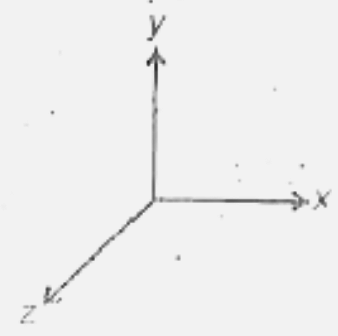A : The poynting vector given as ¯¯¯S=¯¯¯Eׯ¯¯Bμ0 represents the instantaneous intensity at a point.
R : The velocity of an electromagnetic wave is in the direction of the vector ¯¯¯Eׯ¯¯B.
If both Assertion & Reason are true and the reason is the correct explanation of the assertion, then mark (1)
If both Assertion & Reason are true but the reason is not the correct explanation of the assertion, then mark (2)
If assertion is true statement but Reason is false, then mark (3)
If both Assertion and Reason are false statements, then mark (4)
The correct Answer is:B
To solve the problem, we need to analyze the assertion and reason provided in the question.
1. Understanding the Poynting Vector:
The Poynting vector ¯S is defined as:
¯S=¯EׯBμ0
where ¯E is the electric field vector, ¯B is the magnetic field vector, and μ0 is the permeability of free space. This vector represents the instantaneous intensity of the electromagnetic wave at a point in space.
2. Analyzing the Assertion:
The assertion states that the Poynting vector represents the instantaneous intensity at a point. This is indeed true because the Poynting vector quantifies the power per unit area carried by the electromagnetic wave. Therefore, the assertion is correct.
3. Understanding the Direction of Wave Propagation:
The reason states that the velocity of an electromagnetic wave is in the direction of the vector ¯EׯB. According to the right-hand rule, if you point your fingers in the direction of ¯E and curl them towards ¯B, your thumb will point in the direction of the wave's propagation (the velocity vector).
4. Analyzing the Reason:
The reason is also true because the direction of wave propagation is indeed given by the cross product ¯EׯB. However, while both statements are true, they do not explain each other. The assertion describes what the Poynting vector represents, while the reason describes the direction of wave propagation.
5. Conclusion:
Since both the assertion and reason are true but the reason does not explain the assertion, the correct answer is:
- Both assertion and reason are true, but the reason is not the correct explanation of the assertion.
Final Answer:
The correct option is: Both assertion and reason are true, but reason is not the correct explanation of assertion.
---
The Poynting vector ¯S is defined as:
¯S=¯EׯBμ0
where ¯E is the electric field vector, ¯B is the magnetic field vector, and μ0 is the permeability of free space. This vector represents the instantaneous intensity of the electromagnetic wave at a point in space.
The assertion states that the Poynting vector represents the instantaneous intensity at a point. This is indeed true because the Poynting vector quantifies the power per unit area carried by the electromagnetic wave. Therefore, the assertion is correct.
The reason states that the velocity of an electromagnetic wave is in the direction of the vector ¯EׯB. According to the right-hand rule, if you point your fingers in the direction of ¯E and curl them towards ¯B, your thumb will point in the direction of the wave's propagation (the velocity vector).
The reason is also true because the direction of wave propagation is indeed given by the cross product ¯EׯB. However, while both statements are true, they do not explain each other. The assertion describes what the Poynting vector represents, while the reason describes the direction of wave propagation.
Since both the assertion and reason are true but the reason does not explain the assertion, the correct answer is:
- Both assertion and reason are true, but the reason is not the correct explanation of the assertion.
The correct option is: Both assertion and reason are true, but reason is not the correct explanation of assertion.
Topper's Solved these Questions
- ELECTROMAGNETIC WAVESBOOK - AAKASH INSTITUTE ENGLISHCHAPTER - ELECTROMAGNETIC WAVESEXERCISE - ASSIGNMENT SECTION - C Previous Years Questions
22 Videos
- ELECTROMAGNETIC INDUCTIONBOOK - AAKASH INSTITUTE ENGLISHCHAPTER - ELECTROMAGNETIC INDUCTIONEXERCISE - ASSIGNMENT(SECTION -D) Assertion-Reason type Question)
15 Videos
- ELECTROSTATIC POTENTIAL AND CAPACITANCE BOOK - AAKASH INSTITUTE ENGLISHCHAPTER - ELECTROSTATIC POTENTIAL AND CAPACITANCE EXERCISE - ASSIGNMENT SECTION - D
9 Videos
Similar Questions
Knowledge Check
If E and B represent electric and magnetic field vectors of the electromagnetic wave, the direction of propagation of eletromagnetic wave is along.
A→EB→BC→B×→ED→E×→B
If E and B represent electric and magnetic field vectors of the electromagnetic wave, the direction of propagation of eletromagnetic wave is along.
View SolutionThe three vectors ¯¯¯¯¯¯OA,¯¯¯¯¯¯OB and ¯¯¯¯¯¯OC have the same magnitude R. Then the sum of these vectors have magnitude.

View Solution(A) : The average magnitude of poynting vector →S is the intensity of electromagnetic wave. (R) : Poynting vector is given by →S=→E×→B2μ0
View SolutionLight wave travelling along y-direction. If the corresponding ¯¯¯E vector at any time along x-axis, the direction of ¯¯¯B vector at that time is along

View Solution
In the figure shown above, ∠Q measures 70∘ , ¯¯¯¯¯¯PQ≅¯¯¯¯¯¯PR , and ¯¯¯¯¯¯PQ and ¯¯¯¯¯¯PR are tangent to the circle with center O at points A and B . Find , in degrees , the measure of ∠AOB.
View SolutionThe time period of oscillation of a freely suspended bar magnet with usual notations is given by
View SolutionIf z=z0+A(¯z−(¯z0)),whereA is a constant, then prove that locus of z is a straight line.
View Solution
